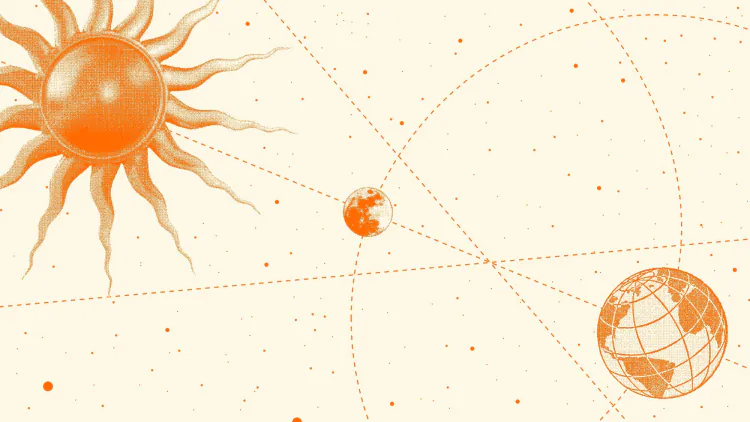Solar Eclipses Are Always With Us
“In celestial spaces shadows cannot fail to fall, and the solid earth must now and then intercept them,” Mabel Loomis Todd wrote in 1897.

This is an edition of Time-Travel Thursdays, a journey through The Atlantic’s archives to contextualize the present and surface delightful treasures. Sign up here.
Cosmically speaking, the alignment of Earth, the sun, and the moon is ordinary. But from our corner of the universe, the occurrence produces something wondrous: a total solar eclipse. On April 8, the moon will pass between the sun and Earth, casting a shadow along a narrow strip of the country, from Texas to Maine. Outside this path, the sun will not disappear, and the best and safest way to observe the event is with eclipse glasses. Inside the path, the moon’s shadow will blot out the sun so completely that, for a few minutes, it will be unrecognizable—a luminous ring in the suddenly darkened sky. You can stare right at it. The difference between a partial eclipse and a total one is, well, night and day.
More than 30 million Americans live inside the path of totality, and millions are expected to travel there for the celestial event. Many before them have been caught in the fleeting shadow of the moon. In 1897, The Atlantic published the writer Mabel Loomis Todd’s account of a total solar eclipse that occurred the year before, in Japan. (Todd is best known for transcribing Emily Dickinson’s original works after the poet’s death and, controversially, making changes to the poems before publication.) By that time, heavenly beliefs about eclipses had given way to natural explanations; Todd witnessed the eclipse as part of a scientific expedition. Astronomers had traveled all this way, with all kinds of instruments with which to observe the spectacle, but they initially “could not bear to look at all the fine apparatus and the extensive preparations, with the prospect of cloud,” Todd wrote.
In 2017, 120 years later, I was just as worried as Todd and her companions seemed to be about clouds obscuring the display. As I waited in a state park in Tennessee, the anticipation became uncomfortable; as Todd described it, “The nerve-tension of that Sunday morning was beyond what one would often be able to endure … Something was being waited for, the very air was portentous.”
When the moon slid over the sun, the sky above me turned a surreal deep purple; for Todd, “unearthly night enveloped all things.” The corona, the outermost layer of the sun’s atmosphere, looked to me like a radiant white ring, but no words felt enough. Todd put it better: “a celestial flame beyond description.”
I remember feeling out of time, the world as I knew it on pause—but when the sun came roaring back, those two minutes of totality seemed like two milliseconds. Time felt scrambled for Todd too:
It might have been hours, for time seemed annihilated; and yet when the tiniest possible globule of sunlight, like a drop, a pin-hole, a needle-shaft, reappeared, the fair corona and all the color in sky and cloud flashed from sight, and a natural aspect of stormy twilight filled all the wide spaces of the day. Then the two minutes and a half in memory seemed but a few seconds—like a breath, a tale that is told.
Eclipses are an eternal echo. They remind us that although our little home is changing all the time, the universe marches on. Our understanding of the depths beyond Earth constantly evolves too: In 1863, a writer named M. D. Conway wrote an essay in The Atlantic about the 18th-century astronomer Benjamin Banneker and his talent for creating astronomical calendars. Banneker, a free Black man who lived in a slave state, correctly predicted a solar eclipse in 1789, contradicting the leading astronomers of the time. “To make an almanac was a very different thing then from what it would be now, when there is an abundance of accurate tables and rules,” Conway wrote, referring to the methods available in the 19th century. Today, computers do the work of producing eclipse forecasts, the calculations buoyed by data from spacecraft that have orbited the moon.
Next week, I’ll be in Niagara Falls, hoping, once again, that the clouds part just in time. When it’s over, I’ll try to imagine 2045, the next time the moon’s shadow will fall across a large swath of the United States, changed in unknowable ways. But, in Todd’s timeless words, “the heavens remain, and sun and moon still pursue their steady cycle. In celestial spaces shadows cannot fail to fall, and the solid earth must now and then intercept them.”
What's Your Reaction?




















